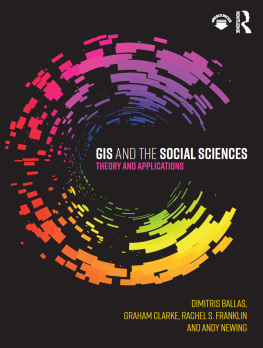Newing - Gis and the social sciences - theory and applications.
Here you can read online Newing - Gis and the social sciences - theory and applications. full text of the book (entire story) in english for free. Download pdf and epub, get meaning, cover and reviews about this ebook. year: 2017, publisher: Routledge, genre: Politics. Description of the work, (preface) as well as reviews are available. Best literature library LitArk.com created for fans of good reading and offers a wide selection of genres:
Romance novel
Science fiction
Adventure
Detective
Science
History
Home and family
Prose
Art
Politics
Computer
Non-fiction
Religion
Business
Children
Humor
Choose a favorite category and find really read worthwhile books. Enjoy immersion in the world of imagination, feel the emotions of the characters or learn something new for yourself, make an fascinating discovery.
- Book:Gis and the social sciences - theory and applications.
- Author:
- Publisher:Routledge
- Genre:
- Year:2017
- Rating:3 / 5
- Favourites:Add to favourites
- Your mark:
- 60
- 1
- 2
- 3
- 4
- 5
Gis and the social sciences - theory and applications.: summary, description and annotation
We offer to read an annotation, description, summary or preface (depends on what the author of the book "Gis and the social sciences - theory and applications." wrote himself). If you haven't found the necessary information about the book — write in the comments, we will try to find it.
Newing: author's other books
Who wrote Gis and the social sciences - theory and applications.? Find out the surname, the name of the author of the book and a list of all author's works by series.
Gis and the social sciences - theory and applications. — read online for free the complete book (whole text) full work
Below is the text of the book, divided by pages. System saving the place of the last page read, allows you to conveniently read the book "Gis and the social sciences - theory and applications." online for free, without having to search again every time where you left off. Put a bookmark, and you can go to the page where you finished reading at any time.
Font size:
Interval:
Bookmark:

GIS and the Social Sciences
GIS and the Social Sciences offers a uniquely social science approach on the theory and application of Geographic Information Systems (GIS) with a range of modern examples. It explores how human geography can engage with a variety of important policy issues through linking together GIS and spatial analysis, and demonstrates the importance of applied GIS and spatial analysis for solving real-world problems in both the public and private sector.
The book introduces basic theoretical material from a social science perspective and discusses how data are handled in GIS, what the standard commands within GIS packages are and what they can offer in terms of spatial analysis. It covers the range of applications for which GIS has been primarily used in the social sciences, offering a global perspective of examples at a range of spatial scales. The book explores the use of GIS in crime science, health, education, retail location, urban planning, transport, geodemographics, emergency planning and poverty/income inequalities. It is supplemented with practical activities and data sets that are linked to the content of each chapter and provided on an eResource page. The examples are written using ArcGIS to show how the user can access data and put the theory in the textbook to applied use using proprietary GIS software.
This book serves as a useful guide to a social science approach to GIS techniques and applications. It provides a range of modern applications of GIS with associated practicals to work through, and demonstrates how researchers and policy makers alike can use GIS to plan services more effectively. It will prove to be of great interest to geographers, as well as the broader social sciences, such as sociology, crime science, health, business and marketing.
Dimitris Ballas is Professor of Economic Geography at the University of Groningen, the Netherlands. He has published widely in the fields of Social and Economic Geography, Regional Science and Geoinformatics in the Social Sciences. His recent books include The Human Atlas of Europe: A Continent United in Diversity (co-authored with Danny Dorling and Benjamin Hennig).
Graham Clarke is Professor of Business Geography at the University of Leeds, UK. He specialises in the application of GIS for service analysis and planning, particularly within the context of health and retailing.
Rachel S. Franklin is Associate Director of the Spatial Structures in the Social Sciences (S4) initiative and Associate Professor (Research) of Population Studies at Brown University, USA.
Andy Newing is a Lecturer in Retail Geography at the School of Geography, University of Leeds, UK. Andy contributes extensively to undergraduate and masters level GIS teaching and student supervision within the social sciences.
GIS and the Social Sciences
Theory and Applications
Dimitris Ballas,
Graham Clarke,
Rachel S. Franklin and
Andy Newing

First published 2018
by Routledge
2 Park Square, Milton Park, Abingdon, Oxon OX14 4RN
and by Routledge
711 Third Avenue, New York, NY 10017
Routledge is an imprint of the Taylor & Francis Group, an informa business
2018 Dimitris Ballas, Graham Clarke, Rachel S. Franklin and Andy Newing
The right of Dimitris Ballas, Graham Clarke, Rachel S. Franklin and Andy Newing to be identified as authors of this work has been asserted by them in accordance with sections 77 and 78 of the Copyright, Designs and Patents Act 1988.
All rights reserved. No part of this book may be reprinted or reproduced or utilised in any form or by any electronic, mechanical, or other means, now known or hereafter invented, including photocopying and recording, or in any information storage or retrieval system, without permission in writing from the publishers.
Trademark notice: Product or corporate names may be trademarks or registered trademarks, and are used only for identification and explanation without intent to infringe.
British Library Cataloguing-in-Publication Data
A catalogue record for this book is available from the British Library
Library of Congress Cataloging-in-Publication Data
Names: Ballas, Dimitris, author. | Clarke, Graham, 1960- author. | Franklin, Rachel S., author. | Newing, Andy, author.
Title: GIS and the social sciences : theory and applications / Dimitris Ballas, Graham Clarke, Rachel S. Franklin and Andy Newing.
Description: New York : Routledge, 2018. | Includes bibliographical references and indexes.
Identifiers: LCCN 2017017403| ISBN 9781138785137 (hardback : alk. paper) | ISBN 9781138785120 (paperback : alk. paper) | ISBN 9781315759326
(eBook)
Subjects: LCSH: Geographic information systems. | Geographic information
systemsSocial aspects. | Social sciencesMethodology. | Social sciences
Data processing. | Spatial analysis (Statistics)
Classification: LCC G70.212 .B35 2018 | DDC 300.285dc23
LC record available at https://lccn.loc.gov/2017017403
ISBN: 978-1-138-78513-7 (hbk)
ISBN: 978-1-138-78512-0 (pbk)
ISBN: 978-1-315-75932-6 (ebk)
Typeset in Minion
by Keystroke, Neville Lodge, Tettenhall, Wolverhampton
Visit the eResources: www.routledge.com/9781138785120
Contents
There are a number of excellent books on the market which provide an introduction to Geographic Information Systems (GIS) and how to get started using GIS (e.g. Heywood et al., 2011; Clarke, 2011). However, as teachers of GIS and spatial analysis for a number of years we have noted the paucity of material that brings together, in textbook mode, the very different areas of GIS application, especially in the fields of human geography and related social sciences. The aim of this book is, therefore, to provide such a textbook which, in turn, we believe helps to emphasise the applied nature of GIS and its usefulness to a wide range of public and private organisations outside the traditional academic environment. There has been no such systematic review of GIS applications in human geography and related disciplines since Longley et al. (1999). The first four chapters of this book provide the basic ingredients that underpin much of the analyses within a GIS framework: mapping, buffer, overlay, network analysis, etc. Although we recognise that the reader could get this material elsewhere, it is important to set out the basics in these first few chapters. This helps the book to be self-contained in that students and researchers new to GIS can get the mixture of theory and application in one publication. The remaining nine chapters take the reader through how these basic techniques are used in geodemographics and deprivation analysis, the study of income and well-being, crime analysis and prevention, retail analysis, health care analysis, emergency planning, education planning, transport planning and environmental justice analysis. Although we concentrate on GIS itself we inevitably have to link GIS to other spatial analysis techniques from time to time, techniques that are not necessarily in standard GIS packages (so called soft coupling). This occurs especially in areas such as retail planning, where the competitive nature of the business requires more sophistication than the normal GIS functions can routinely offer. However, there are examples too in other fields.
In addition to the review chapters we offer a series of hands on practical activities for you to undertake using ESRIs ArcGIS software. These practicals support understanding and development of the techniques that we introduce and the application areas we discuss. We could have chosen many alternative packages for these practicals, including a number of open-source GIS. However, ArcGIS (Desktop) is one of the major GIS systems used within academia, governmental and commercial sectors around the world. It is a versatile and popular GIS package that incorporates data storage, manipulation, visualisation and analysis capabilities. We assume no previous experience in using this GIS software and, while we do not seek to provide a comprehensive guide to ArcGIS itself, readers will become confident in handling spatial data in ArcGIS and undertaking analytical tasks employed by social sciences. Teachers who use other packages should be able to translate the instructions from ArcGIS into other formats or indeed re-write the instructions while keeping the valuable data sets and suggestions for analysis that are provided.
Font size:
Interval:
Bookmark:
Similar books «Gis and the social sciences - theory and applications.»
Look at similar books to Gis and the social sciences - theory and applications.. We have selected literature similar in name and meaning in the hope of providing readers with more options to find new, interesting, not yet read works.
Discussion, reviews of the book Gis and the social sciences - theory and applications. and just readers' own opinions. Leave your comments, write what you think about the work, its meaning or the main characters. Specify what exactly you liked and what you didn't like, and why you think so.



